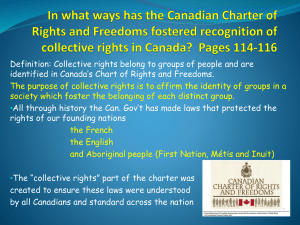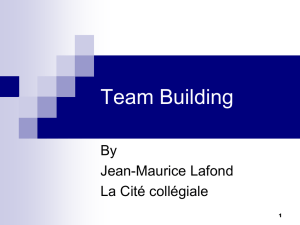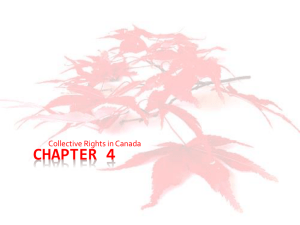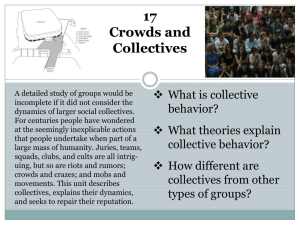Collective Rights
advertisement
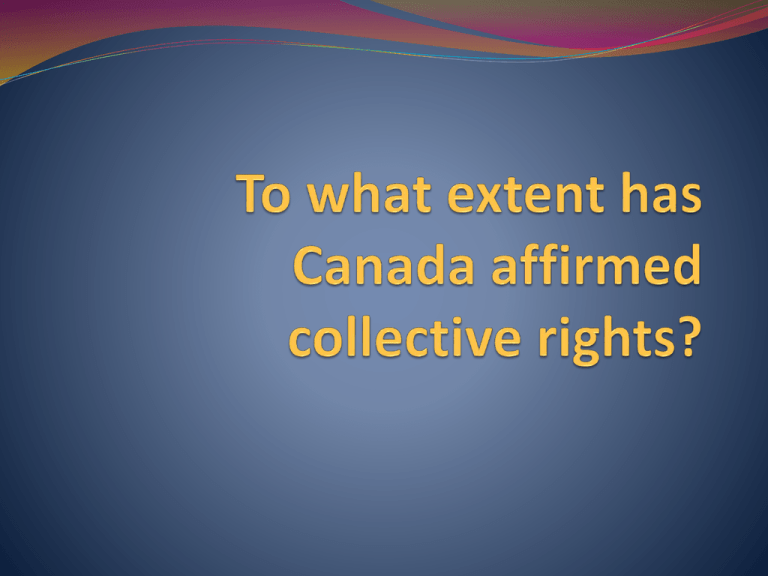
Introduction Let’s turn to page 118 and find out more about our focus. With a partner: Read the introduction Identify what “affirm” means Read over page 119 and answer each question that is paired with a caption and photo. Canada is a nation that is built on immigration. However, long before our nation became Canada, Aboriginal peoples lived throughout the land. They had their distinct identity and way of life. Then during the age of exploration, Europeans began to explore North America. Immigration soon followed and has continued as Canada has become a multicultural and diverse nation. In 1982, the Canadian Charter of Rights and Freedoms acknowledged the collective identities and collective rights of the founding groups: the Aboriginal peoples, the Anglophones, and the Francophones. Today, Canada has laws and policies to ensure the rights of all Canadians. A collective is a group that shares or is motivated by a common interest. This protection of rights, called collective rights, is guaranteed in the Canadian constitution (our laws). No other country has this type of legislation to protect the collective rights of a specific group. Not every collective, however, enjoys this type of protection. You will examine how the government of Canada protects all Canadians through the establishment of collective rights that works to strengthen the nation. Back to individual identity Your identity as an individual describes who you are. This identity is unique based on your personal characteristics, values, experiences, and personal interests. Stop and think about what defines your individual identity. Part of your individual identity includes the cultural group you belong to and the place you are living. Are you a Canadian citizen? You may be a Canadian and also belong to another cultural group. Perhaps you're a member of Canada's First Nations, for example, or Inuit. Or maybe you're a Francophone or have a Ukrainian heritage. As a Canadian, you have a Canadian identity. Stop and think what defines a Canadian identity. Your individual identity is also influenced by the groups or collectives that you belong to. What groups do you belong to here in Sherwood Park? Do you participate in a group sport, play in a band, or attend a local boys or girls club? Perhaps you are a member of a youth group. Each group has its own collective identity. The collectives you belong to help to define your individual identity. Let’s compare identities individual and collective identities Canadian identity is based on strong values shaped by our history and our diversity. Canadian values are part of the identity that describes who we are within the global community as well. You are part of the Canadian collective. You share common traits with other Canadians. Your individual identity is influenced by the fact that you are part of that Canadian collective. Part of your individual and Canadian identity is the rights and freedoms guaranteed under the Charter of Rights and Freedoms. Every individual in Canada, whether they are a Canadian citizen or a permanent resident, has individual rights. In the last chapter you explored the individual rights that the Charter ensures. You have investigated the fundamental freedoms for all Canadians. The Charter also protects the rights of certain groups of people. The protection of group rights is known as collective rights. While there are many Canadian collectives, Canada has recognized the importance of three collectives through their protection in Canadian law. The special groups that have guaranteed collective rights include the founding peoples of Canada: Aboriginal peoples, Francophones, and Anglophones. The federal government has established collective rights to assist in protecting the collective identity of each group. The foundation of Canada’s history is based on histories of the Aboriginals (First Nations, Métis, and Inuit), Francophones, and Anglophones. The Canada that we know today would be very different without the contributions of these three groups. Collective rights for these founding groups are based on historical legislation and constitutional rights. Collective rights in Canada are rights guaranteed to these founding groups. What legislation relates to collective rights? Let’s look at Legislation relating to collective rights to explore the different laws that affect the collective rights of each of our founding peoples. We will be studying the legislation throughout this chapter. Let’s turn to page 122 to explore some facts about collective rights. Be prepared to discuss the BTQ. Did you think of… Collective rights demonstrate that Canadians value the contributions of the founding peoples and work to maintain mutual respect among peoples of all origins. When resolving modern-day issues, Canadians must consider the collective rights of all groups involved. Without this respect, the issues are not likely to be solved. Canada is unique because many countries do not have collective rights explicitly written out in the constitution for groups within them.


